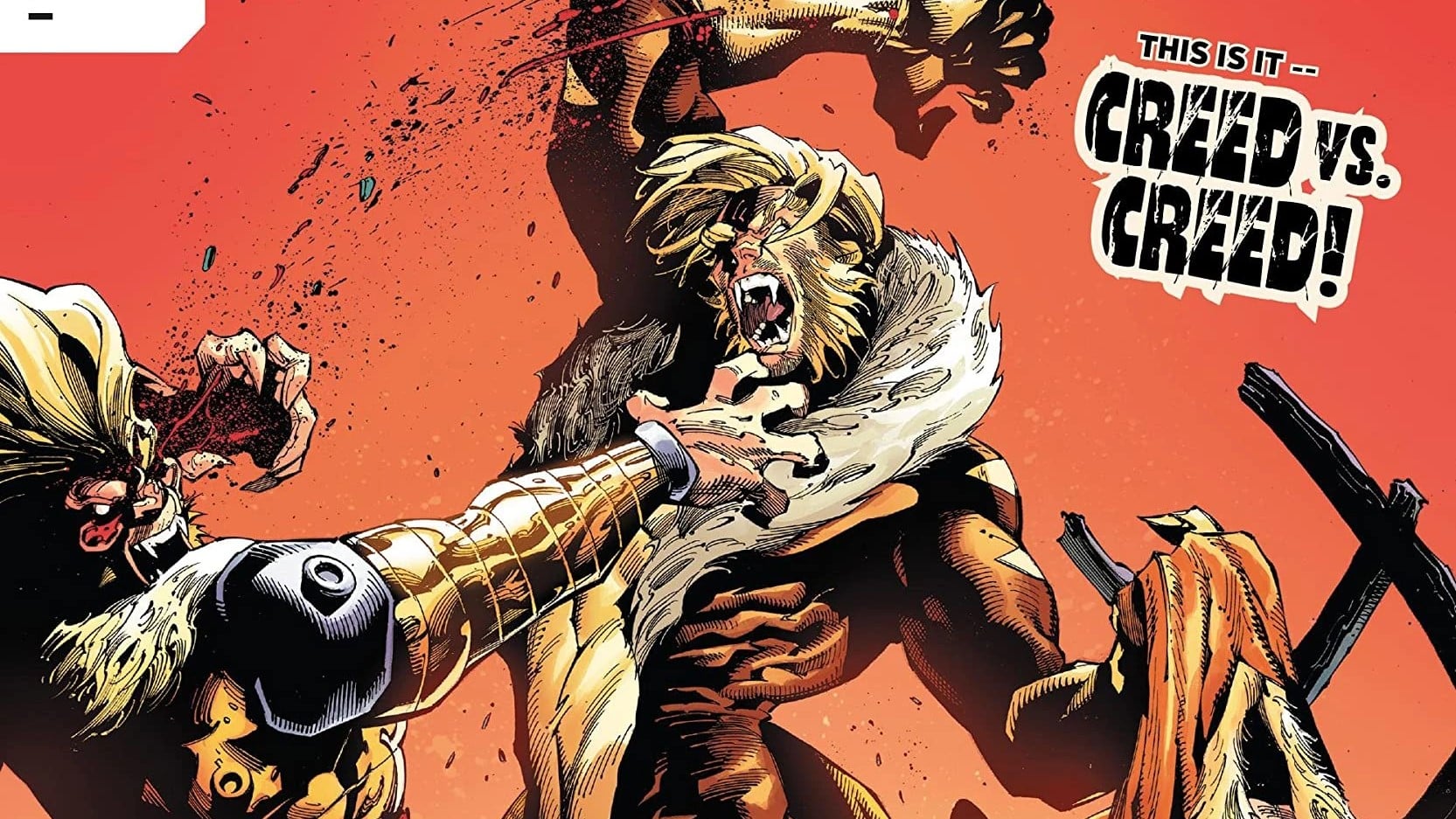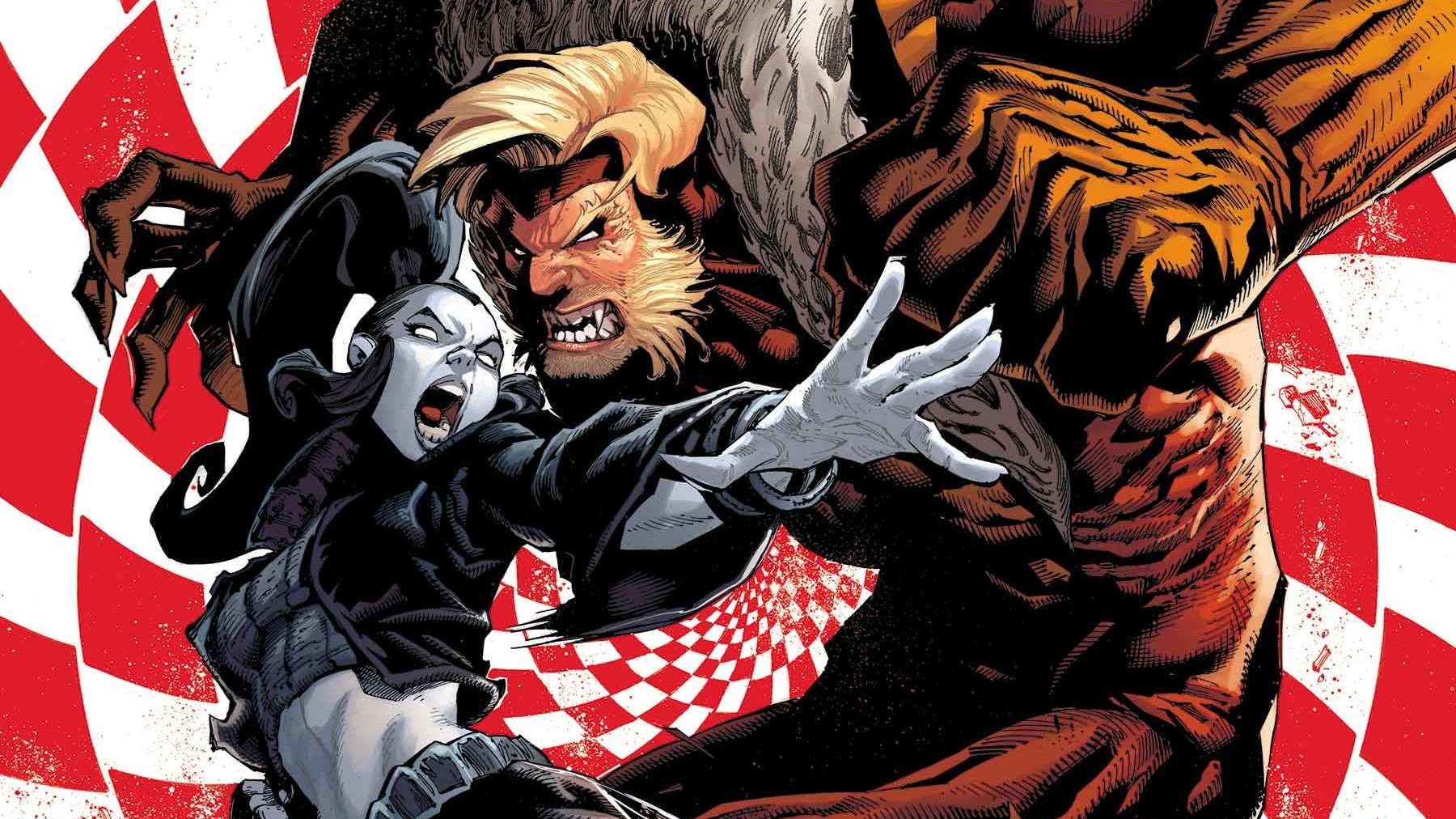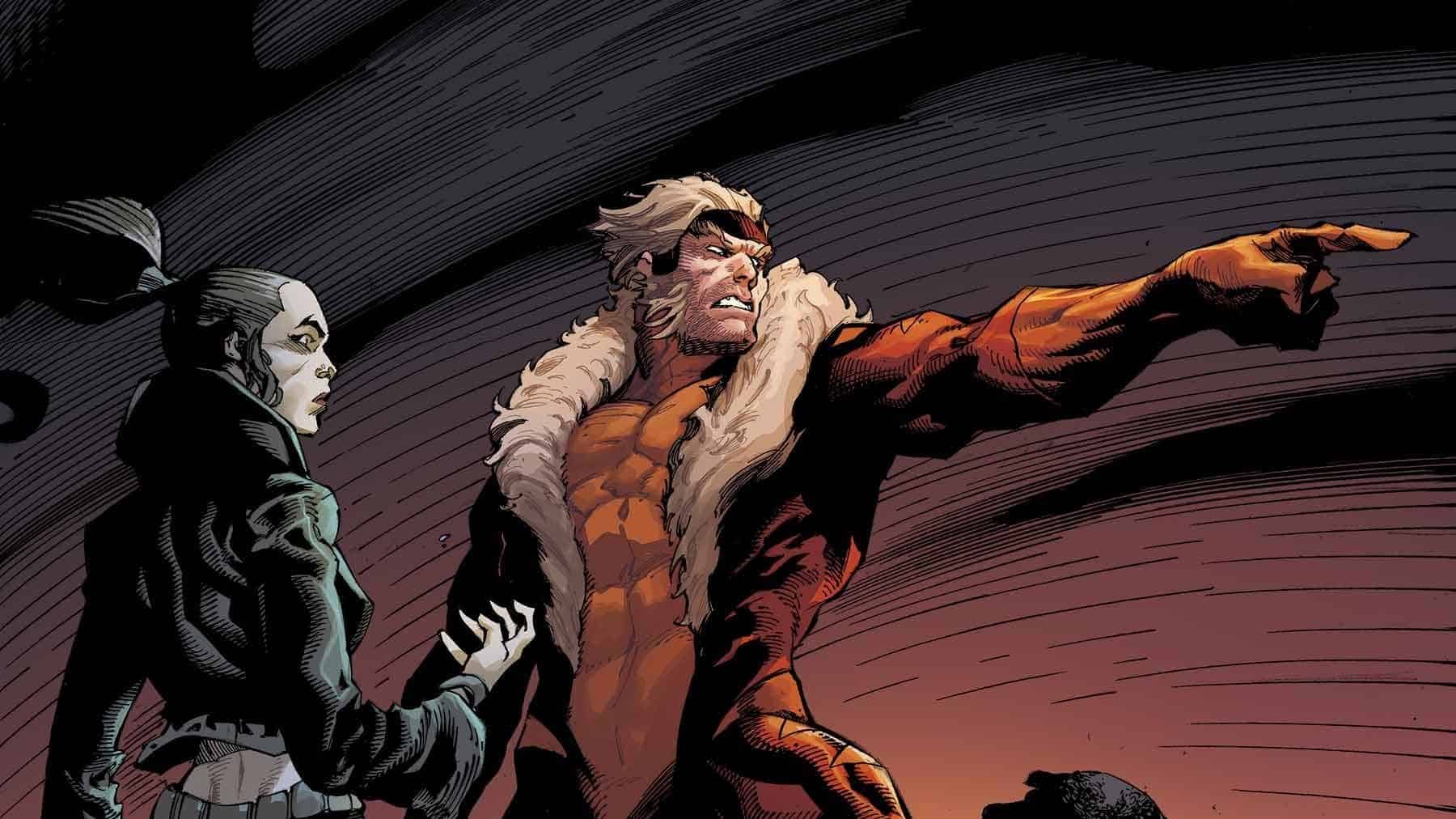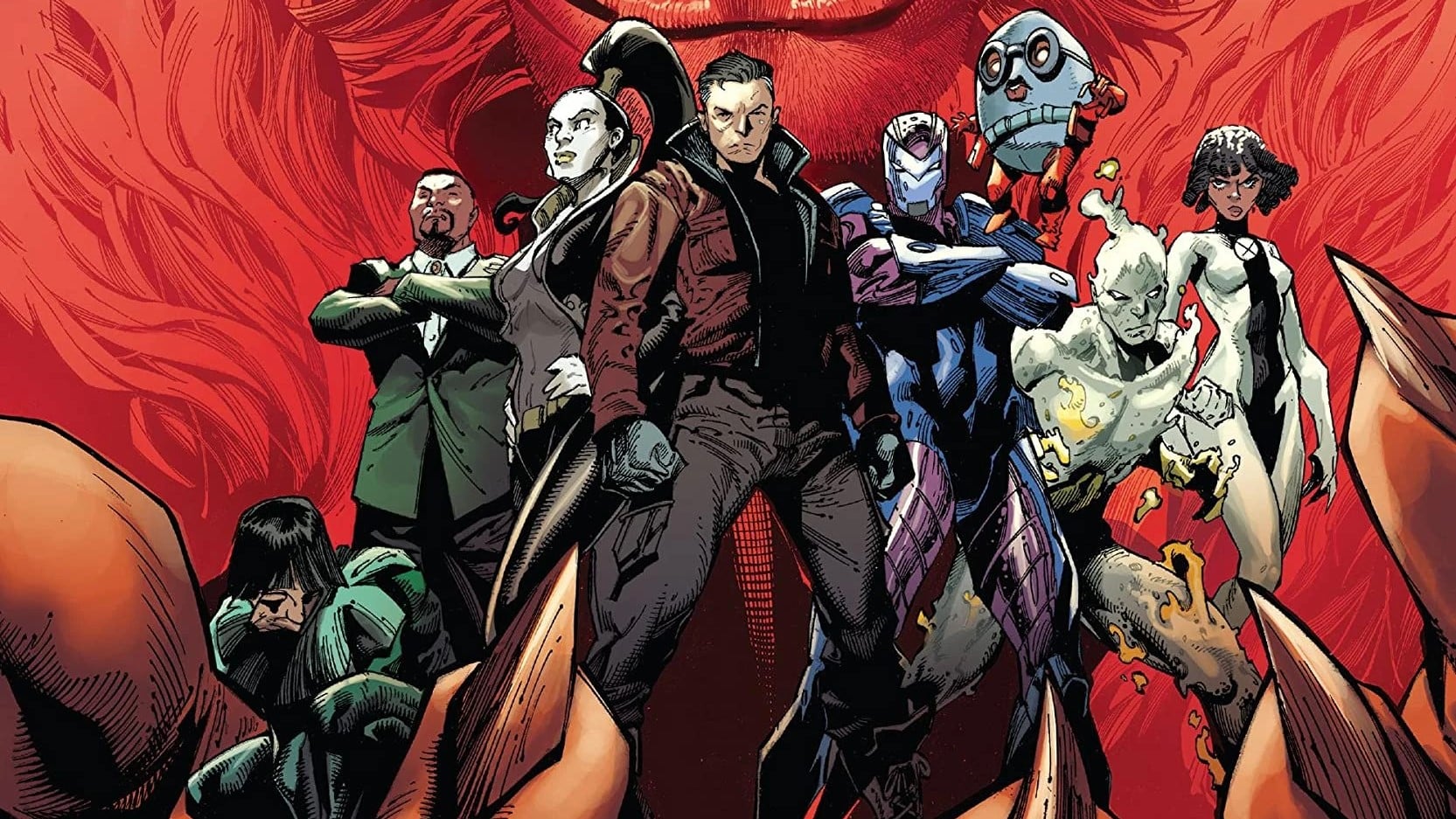Some people come face-to-face with themselves, other people get ripped in half, and a new generation of outsiders searches for hope and better leaders in a revelation-packed Sabretooth and the Exiles #4, written by Victor LaValle, drawn by Leonard Kirk, colored by Rain Beredo, and lettered by Cory Petit.
Anna Peppard: I have a specific memory from two years ago. It starts with taking my mother to chemotherapy. On the way, I drove past 215 pairs of children’s shoes, laid neatly, row by row, upon the steps of the Kingston, Ontario City Hall. I also drove past the statue in City Park of Canada’s first Prime Minister, Sir John A. Macdonald, swathed in blood red cloth with a crowd camped around it, and police keeping a watchful eye on the crowd.
These new landmarks were responses to Canada’s ongoing reckoning with the legacy of the Residential School System, a policy of forced relocation and reeducation of Indigenous peoples that was active between 1896 and 1996, dreamed up and overseen by the Canadian government and various Christian organizations. The demonstrations were in response to what was, at that time, the latest development in that reckoning. Members of the Tk’emlúps te Secwépemc Nation had used ground-penetrating radar to discover 215 unmarked graves outside the former Kamloops Indian Residential School, belonging to children as young as three. Since then, more graves have been uncovered; experts estimate there are thousands. The Residential School system is often described as a cultural genocide. It was designed to systematically eliminate Indigenous identity and culture. But every day, it becomes clearer to more people that it was also a very physical genocide. So many children were taken from their families and never came home, simply because they weren’t white or Christian. Many who survived endured horrific abuse.
Since 2021, some reconciliation has occurred. The statue of Sir John A. Macdonald has been removed from City Park. The Pope issued an apology (sort of) and the Canadian government has offered compensation and funding to search for more graves. And Canada has a new statutory holiday, the National Day for Truth and Reconciliation, meant to recognize the legacy of Residential Schools. But it’s not enough. It will never be enough.
Sabretooth and the Exiles #4 only mentions the US version of Residential Schools briefly, in a data page, before moving on to more fantastical contexts. But even this brief mention is more information than I ever received, as a white settler, in Canadian public school and throughout most of my postsecondary education. At most Canadian universities, a survey course on Canadian Literature is a degree requirement for anyone majoring in English. Back in 2004, my Canadian Literature survey didn’t include any texts by Indigenous writers. That’s what genocide does; it removes bodies and ideas and reshapes history to suit the perpetrators. I’m pissed off and heartbroken about all of that but I’m definitely not mad at this comic. This is a bit of a set-up issue, but I remain deeply grateful for the connections this comic makes between lived realities and metaphors, illuminating the former while enriching the latter.
Jude Jones: Lost in the endless conversations about CRT and censorship is a sad truth: we westerners do not know our history. Our societies are built upon atrocity after genocidal atrocity, and we (quite intentionally) make due day to day, none the wiser. That a *comic book* yields more information than history classes should be a problem; sadly, at least in the United States of DeSantis, it only looks like the problem will get worse. I, like Anna, and also pissed off and heartbroken about all of this.
Unlike Anna, a little bit of that heartbreak involves this issue.
Sabretooth and the Exiles, delivered as a five issue mini-series, is a gift and a curse. It tells a definitive story with a beginning; middle, and end – no superfluous digressions into the crossover of the month, just a tight focus on characters and story. This, of course, is the gift. But the curse, unfortunately, plagues this penultimate edition of the tome: for it feels as if, for the sake of keeping the beginning middle and end to a set number of pages, something had to be moved, cut, or all together eliminated.
And we can tell.
Which isn’t to say this issue is bad or even uneven. It still has a stinging, sarcastic sense of humor, the obligatory (and sadly necessary) data page history lessons, and (more than) enough heart to compensate for its heartless namesake. Still, the comic, like its tortured characters, feels keenly aware of its own mortality. The comic knows that it’s about to end, thus issue four is all about setting up the pieces for the final showdown(s).
Everyone here is busted, brushed, and beaten. All of the people – even the antagonists – are just scraping by.
And you know what they say about hurt people.
They hurt people.
And lots of people are getting hurt.
Crew Love

Jude: Last issue we were in the Astral Plane, fighting the impending destruction of all things from Orphan-Maker, hurredly trying to find a way to escape from a collapsing, cascading Orchis torture farm. Things were looking bleak. I was genuinely curious how things would work out.
And, well…
I guess everything is… fine? Several narratively important steps – the escape, the threat of annihilation by Orphan-Maker, the discovery of a whole other Victor Creed – were taken with use of exposition as opposed to illustrated action. This is unsatisfying – maybe my first real quip with the work. Yes, the focus was always on how communities were cared for or abused, not long-nebulous apocalyptic power sets. I get that. Still, there had to be a better way of closing that narrative arc than just skipping over it, no? Maybe we get it next issue, but given the bevy of plot threads moving in this one, I’m not so sure.
In any case, the new look Orphan-Maker (how did they move his physical casing from the astral plane?) is here; the survivors are too, in an enlarged version of Bling!’s Angel mothership, newly christened the Maroon, after Madison Jeffries used his gifts to expand the shop to accommodate over 1000 passengers.
And Victor Creed? Our Victor Creed? He’s still here too, barely able to stand, surviving on instincts and pride alone. Sabretooth holds court with our maroons, pontificating profusely, using all available strength to puff out his chest and make his revenge fantasy feel purposeful and profound. And it works! And it *should* work. What little insight we’re given into his talk weaves truth into his lie: they weren’t going to let them out the Pit; Krakoa, by its action and inaction, isn’t welcoming of all mutants; they don’t look the part (note only human-passing mutants have made successive iterations of the X-Men). He riles up righteous anger and then aims in the direction he chooses. It’s the same game he ran on our original Exiles; I expect it would have worked just fine here. As Toad, a one-time acolyte of a more noble but just as selfish autocrat notes: “…you’d be surprised what angry people will do for their leader.”
Again, what’s explained in exposition seems unduly pertinent: how did the other Victor manifest in our world without a body? The explanation given boils down to “it’s a comic,” which, in another comic, would be fine. I’ve come to expect tighter writing here, and this feels a little too rushed, convenient, and quite frankly disappointing.
Anna: I’m a bit more forgiving of the comic’s decision to bypass some of the specifics of what happened on the Astral Plane, if only because I think the Astral Plane works better the fewer rules you give it. As soon as you start to apply logic to that space, some of the wonder and mind-bending danger gets lost.
But I do understand the frustration, and I have a few quibbles of my own regarding pacing and the way this comic – and this series as a whole – sometimes tells instead of showing. Thought bubbles were once common in superhero comics, but fell out of favor in the 1990s, for various reasons. Some comics dropped them to feel more “mature” and naturalistic, others dropped them in pursuit of visual excess, typified by the Image comics of the early 90s. These days, thought bubbles are rare enough that even seeing one can be jarring, and I can’t help feeling that about Toad’s thought bubble in this issue, in which he reflects on being excluded by the other Exiles. It feels like an instance of the writer not trusting their artist, but actually – Kirk’s image of Toad, sad and longing and cloaked in ominous shadow – communicates the message just fine. In any case, something’s being set-up for Toad, and I’m guessing it’s going to come to a head sooner rather than later.
Nice for What

Jude: “What’s Krakoa like?”
This, of course, is a charged question. Is it a utopia, or a home of broken dreams? Is it a home for all, or just another place for the privileged to exert power over others?
I think of church. A place supposedly open to all, but all too often caught up in politics and patriarchy. The Black Church, specifically, served as an important organizing ground for civil rights. It’s also been incredibly slow to accept female leadership and queer rights. It, in too many ways, mirrors biases it so effectively rallied against. Obviously this isn’t every single church house; remember, perfect analogies don’t exist. Still, to see a young person ask for inclusion, only for those rejected by the institution to bring them down to reality – it’s heartbreaking.
Which brings me to another issue: we don’t really see the heartbreak. The Exiles aren’t just deprived of agency by Orchis and Xavier; they’re not really given much agency here. We don’t see the reaction to Nanny telling them their dream is a lie; we don’t hear them embrace (or reject) Sabretooth’s Trumpian rabble-rousing. Maybe that’s the cost of a five-issue series: everyone can’t get a line. Shame though that, yet again, the inconvenient are discarded.
Also, note that the only Exiles with dialogue – the transporter Bab and the emotion-manipulation Herd – are human presenting. Note that almost every other Exile doesn’t present this way. Note that biases can always present, even when writing about the evils of them.
Anna: I still can’t personally fathom signing up for citizenship in a nation where you have to get birth control out of someone’s purse and there definitely isn’t democracy or due process, but I guess the bar seems fun? I’m being facetious; Krakoa has always been a story about the power and pitfalls of nation-building, and that’s fine. If you enjoy the Krakoa era of comics, you probably agree this nation’s deep flaws are part of what makes it interesting, as a fictional place and as a storytelling prompt. My main gripe with Krakoa is the inconsistency of the vision; this is a much more hopeful and inclusive space in some books than others. But there’s also a way to chock that up to whose perspective is being foregrounded in which moments, which brings us back to our Exiles.
Victor Creed’s solution to the problem of Krakoa is quite obviously unviable. He’s not proposing reform; he’s only offering revenge, which is clearly self-serving. But can the other Exiles offer anything better? I hope so. With Sins of Sinister raging, and given the ways this comic ties the genocidal exclusion and abuse of the Station Two mutants to real-life abuses that already weigh heavily on me, I could use an injection of hope.
Jude: Ah, the lost Station Four, home of the infernal Nursery. Home of children, babies, lost to society, lost to science, and now lost at sea. The data page talks about the subjugation and intentional killing of Indigenous culture through abduction and indoctrination of children. These mutant children clearly rebelled. Their anger was likely righteous. Lost, in this case, may also mean unwilling to be compromised and all too willing to assert themselves.
Are they attacking everyone indiscriminately? Yes, but again, they’re babies, and everyone they’ve known abandoned or attacked them. Just like our maroons on the Maroon, no mutants came to save them. They’re just as complicit, and, I imagine from those kids’ standpoint, just as worthy of destruction. I can’t blame them. They are well within their logical right to burn the world.
I completely understand.
Started from the Bottom

Jude: What was thought lost and buried has borrowed its way to the light, as all hidden secrets are wont to do. The Babies from Station Four have grabbed Barrington and her Creation, and are now attacking the Maroon, seemingly killing Madison Jeffries.
And yet, I’m willing to bet all of my editor’s money thay Madison Jeffries is not dead. [Ed. note: Hey, wait what?!]
Yet “Madison Jeffries” is likely no more.
Both things are likely true.
In the original series, Jeffries slowly began to present himself in a less “traditionally” human way, slowly transitioning his outward appearance into something that better reflected his spirit. He has the ability to transmute plastics and other inert materials to his will, materials that are more than bountiful in the sea. One might even argue that his body is limiting, an unnecessary constraint, a capitulation to the wiles of those who would ignore him, or imprison him. He was well aware that there was something amiss in the water; he likely sacrificed himself to give the rest of the team a fighting chance.
But sacrifice doesn’t necessarily equate to death. My guess: he relinquished the last of his blood and bone presence to provide the Station Four kids the bloodshed they desired. Don’t be surprised to see him next issue, fully in control, no longer entombed under the expectations of others.
Again, Madison Jeffries is no more. We, and he, are likely all the better for it.
Anna: I am similarly quite sure Madison hasn’t left us for good. He makes a conscious decision to stay on the deck as the water swirls and bubbles off the prow of the ship. It feels less like a random “death” than an intentional one – like Madison was tempting fate as an excuse to try something new. I’m looking forward to seeing where this goes.
I’m also looking forward to seeing more of what’s going on at Station Four. On the opening pages, we saw a guard merged with a wall, and now we’ve got a mega-powerful water monster that may be purposeful or might simply be ripping people in half and swallowing ships because it’s primally scared, angry, or trying to protect itself. I won’t deign to predict how these themes of merging and dissolution relate to Orchis’ attempt to harness the raw power of mutant babies, but part of me wonders if “babies” is a red herring. That word can mean lots of different things, after all. We’ll see.
Jude: “He left you with us, but we won’t let you die.” There is no other line that exhibits my love for this series; no panel that proves the point and purpose of this series more.
The best of Krakoa revolves around community: working together as a unit, as the only means to save that community. This is how resurrection works with The Five. This is how Arrakko was saved by The Brotherhood. And here, separated physically and emotionally from Krakoa, the Exiles show the best of Krakoa. Oya could have easily tried to save herself, or just her team. She could have used the opportunity to make a (well earned!) quip at Sabretooth. But no, she recognizes her responsibility and earns the trust of those she seeks to help. She may not be Orphan-Maker’s Nanny, but she is Nanny of the Maroons.
“At the risk of seeming ridiculous, let me say that the true revolutionary is guided by a great feeling of love.”
Che may never have met Oya, but he most certainly knew her spirit.
Anna: Look, I know a lot of you enjoy Captain Kate Pryde, but I’m all-in on Oya becoming everyone’s new favorite mutant pirate. Not that we have to choose one over the other – I’m all for more mutant pirates in general. I also love that line you quoted. I’ve been trying to incorporate literary references into these reviews, but if you’ll permit me a sillier intertext this one time – Oya’s line reminds me of one of my favorite moments from the original Jurassic Park, where Lex is freaking out about the lawyer guy leaving her and Tim behind to almost get eaten by a T-Rex. She’s all like, “He left us!” And Sam Neill’s Alan Grant is like, “But that’s not what I’m going to do.” That’s some pure hero shit right there.
Jude: It was Graydon. Of course it was Graydon. It was always going to be Graydon. From the moment a character with the initials GC was announced, it was clear, almost bluntly obvious, that Sabretooth’s flatscan, mutants hating son would show up. And still, his presence, no matter how clearly telegraphed it was, still felt appropriate, earned, and not the least bit rote. Of course he would work with Orchis; their goals are aligned. Of course he wouldn’t be good at working with them; the man’s clear focus has always been revenge borne from abandonment – in a way, not so different than the kids causing indiscriminate ruckus from Station Four. Considering how many times he’s been killed (and even zombified, because of course, why not, comics!) it will be interesting to see how he willed himself back to life; considering he’s traveling the multiverse to hunt every version of Sabretooth, it’s worth wondering if he’s even from the 616 reality.
[Ed. note: Because it’s going to bother me if I don’t mention it. 616 Graydon was resurrected right before House Of X #1 in the book Weapon X where the AXIS inverted Sabretooth sacrificed all of the goodness in his soul to Nightcrawler’s dad Azazel in exchange for giving Graydon, his truly horrible son, a second chance at life. Comics are what they are.]
Regardless, he’s here. He’s failed, miserably, and yet he’s gotten the only thing he’s really wanted: a chance to kill the last version of his father, (barely) standing. Will he succeed? Does a bad person, maybe even one of the worst people alive deserve redemption on his terms?
We will see. We will see.
X-Traneous Thoughts:
- Nanny appearing out of nowhere when you say children is really, legitimately hilarious.
- What does Mystique feel towards Graydon? I mean, she did kill him once, but still – that’s your (genocidal) baby. [Ed. note: I’m struggling to think of one of Mystique’s many children that she hasn’t tried to kill at least once.]
- All of the Exiles fit in perfectly – physically, spiritually, thematically – in Arakko. If Sabretooth was the Inferno, and the Exiles Purgatorio, then maybe Arakko would be Paradiso?
- Speaking of which, even though my money is on Craig Robinson of NASA, I’d find it hilarious if Third Eye became Storm’s new love interest. But I’m getting ahead of myself here. Let’s get the Exiles safe first.
- Why hasn’t he asked for help to get the coil out? A mutant circuit of Nanny, Madison, and Third Eye seem like they’d be able to do the job, no? Probably because his pride won’t allow him to appear weak, and the Exiles aren’t willing to volunteer help to someone who’s repeatedly turned on them. Still, this puts Sabretooth in a precarious predicament: he who relied on physical violence is now completely dependent on his voice and the memories of his deeds. Nothing more.







